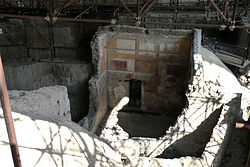Somma Vesuviana
Somma Vesuviana | |
|---|---|
 Panorama di Somma Vesuviana | |
 Coat of arms | |
show Location of Somma Vesuviana | |
 Somma Vesuviana Location of Somma Vesuviana in Italy | |
| Coordinates: 40°52′21″N 14°26′13″E / 40.87250°N 14.43694°ECoordinates: 40°52′21″N 14°26′13″E / 40.87250°N 14.43694°E | |
| Country | Italy |
| Region | Campania |
| Metropolitan city | Naples (NA) |
| Frazioni | Somma, Mercato Vecchio, Casamale, Rione Trieste, Santa Maria del Pozzo, Starza della Regina, San Sossio |
| Government | |
| • Mayor | Salvatore di Sarno |
| Area | |
| • Total | 30.74 km2 (11.87 sq mi) |
| Elevation | 165 m (541 ft) |
| Population (December 2017)[2] | |
| • Total | 34 981 |
| Demonym(s) | Sommesi |
| Time zone | UTC+1 (CET) |
| • Summer (DST) | UTC+2 (CEST) |
| Postal code | 80049 |
| Dialing code | 081 |
| Patron saint | St. Januarius |
| Saint day | September 19 |
| Website | Official website |
Somma Vesuviana is a town and comune in the Metropolitan City of Naples, Campania, southern Italy.
History[]


Before the Roman colonisation, the area of today's Somma Vesuviana was probably inhabited by Italic peoples like Samnites and Oscans.
Later it became a resort for rich patricians of Rome or for rich estate owners who built magnificent villas in the area.
Excavations have shown that this north side of the Vesuvius volcano was equally as populated as the southern side where Pompeii and Herculaneum lie, but has not been paid as much attention by historians. The area was buried during the eruption of Vesuvius of 472 AD[3] and not 79 AD (like that which buried Pompeii etc.), and so was part of the community that continued after the earlier eruption and recovered better than the territories to the south.
Excavations[]
A large Roman villa was discovered in the 1930s in the frazione of Starza della Regina, and interpreted as that of emperor Augustus[4] at Nola where he probably passed his last days of life.[5]
Baths of a Roman villa were also discovered in nearby Pollena Trocchia in 1988 and subsequently exposed.
Among the vestiges at Somma then discovered was a majestic colonnade with arches oriented 12 m long,[6] connected to wall decorated with three niches. Marble columns and capitals, mosaic floors, splendid fragments of statues depicting people with sumptuous robes, polychrome frescoes and coffered ceilings were discovered.
In 2002 excavations on the villa started again.[7] Part of the villa has been brought to light with its rich decoration.[8]
The part then excavated includes a monumental entrance of a vast Roman villa dating from the mid-2nd century AD, used as audience halls for visitors.[9] They had apses that were richly decorated with frescoes. Another room was paved with marble slabs and a mosaic, but later was divided into two parts for food storage and a stable.
More recent excavations in 2015 have revealed a massive water cistern for irrigation of farmland from the 4th century.[10]
Main sights[]
- The ancient quarter of Casamale has walls of Aragonese times.
- The Collegiata church
- Church of San Domenico
- Church of Santa Maria del Pozzo (15th century). Its cloister is home to a museum of the peasant culture of the area.
- Palazzo de Felice, a 16th-century palace and ancestral home of the de Felice family.
References[]
- ^ "Superficie di Comuni Province e Regioni italiane al 9 ottobre 2011". Istat. Retrieved 16 March 2019.
- ^ "Popolazione Residente al 1° Gennaio 2018". Istat. Retrieved 16 March 2019.
- ^ Journal of Volcanology and Geothermal Research Volume 113, Issues 1–2, 15 March 2002, Pages 19–36, The 472 AD Pollena eruption of Somma-Vesuvius (Italy) and its environmental impact at the end of the Roman Empire
- ^ Aoyagi, M., De Simone, A., & De Simone, G. (2018). The “Villa of Augustus” at Somma Vesuviana. In A. Marzano & G. Métraux (Eds.), The Roman Villa in the Mediterranean Basin: Late Republic to Late Antiquity (pp. 141-156). Cambridge: Cambridge University Press. doi:10.1017/9781316687147.011
- ^ Suetonius, Augustus, 98-100
- ^ GB Villa where Augustus probably died is unearthed https://www.youtube.com/watch?v=AJAcZ8CWVMA
- ^ https://www.youtube.com/watch?v=jMuvzJR3F_8
- ^ "Apolline Project". www.apollineproject.org. Retrieved Jul 27, 2019.
- ^ "3D animation presents the glory of the 'Villa of Augustus' in Somma Vesuviana". 18 November 2016.
- ^ Huge water cistern found at the ‘Villa of Augustus’ near Nola https://www.pinterest.co.uk/pin/54676582956568602
- Cities and towns in Campania
- Municipalities of the Metropolitan City of Naples
- Archaeological sites in Campania
- Roman villas in Italy
- Somma Vesuviana
- Campanian geography stubs



